"retrospective "Frank Bowling
curated by Elena Crippa
presented by the gallery :
Alexander Gray Associates
510 West 26 Street, New York NY 10001 United States+1 212 399 2636 e-mail:


in collaboration with the galleries :
HALES GALLERY
Tea Building 7 Bethnal Green Road London E1 6LAT 44 (0)20 7033 1938 F 44 (0)20 7033 1939e-mail:


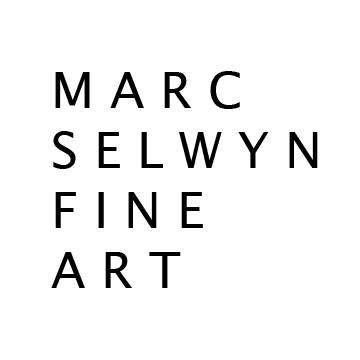
SELWYN MARC FINE ART
9953 South Santa Monica Boulevard Beverly Hills, CA 90212T. 310.277.9953 F. 310.277.9955 e-mail:



Tate Britain, London
Millbank London SW1P 4RG
T. +44 (0)20 7887 8888 e-mail:
31 May > 26 August, 2019
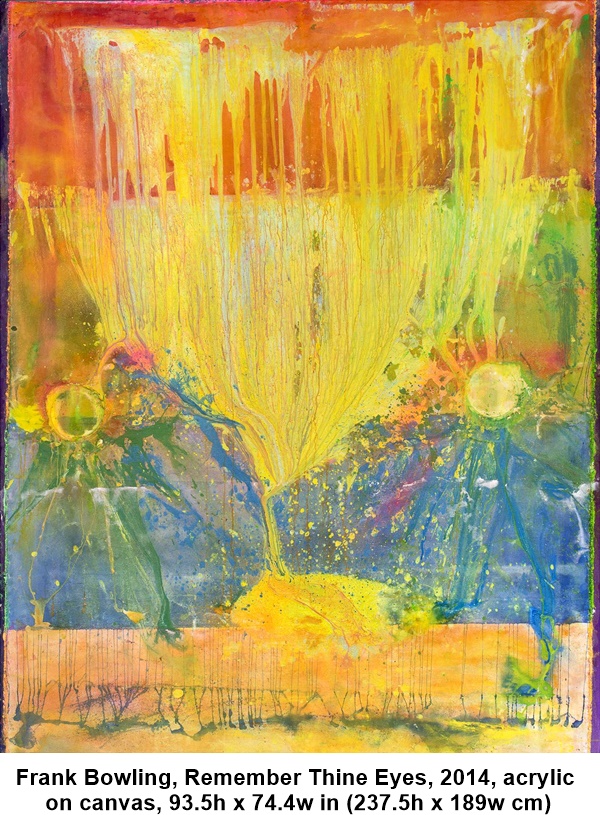 |
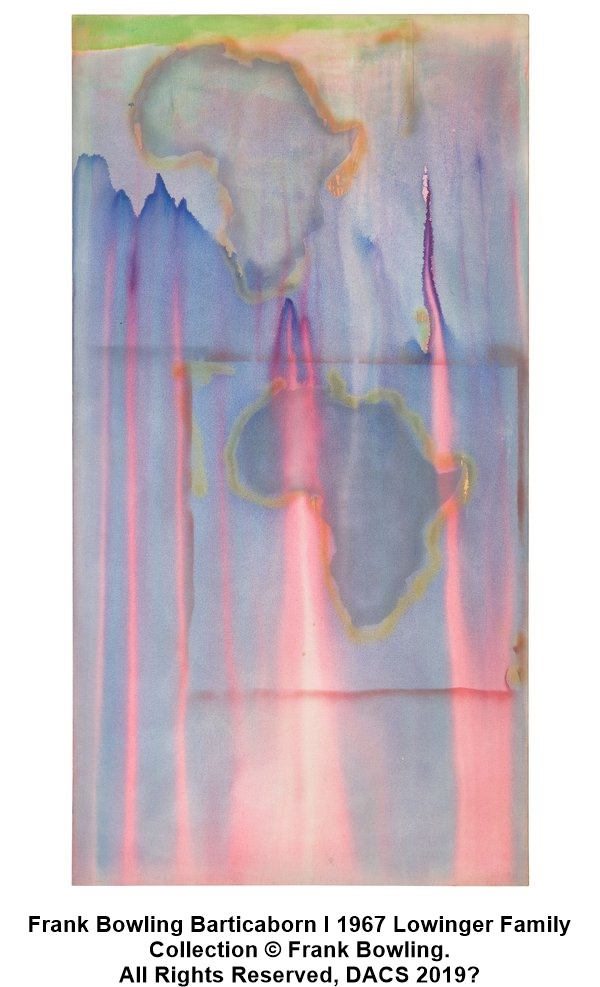 |
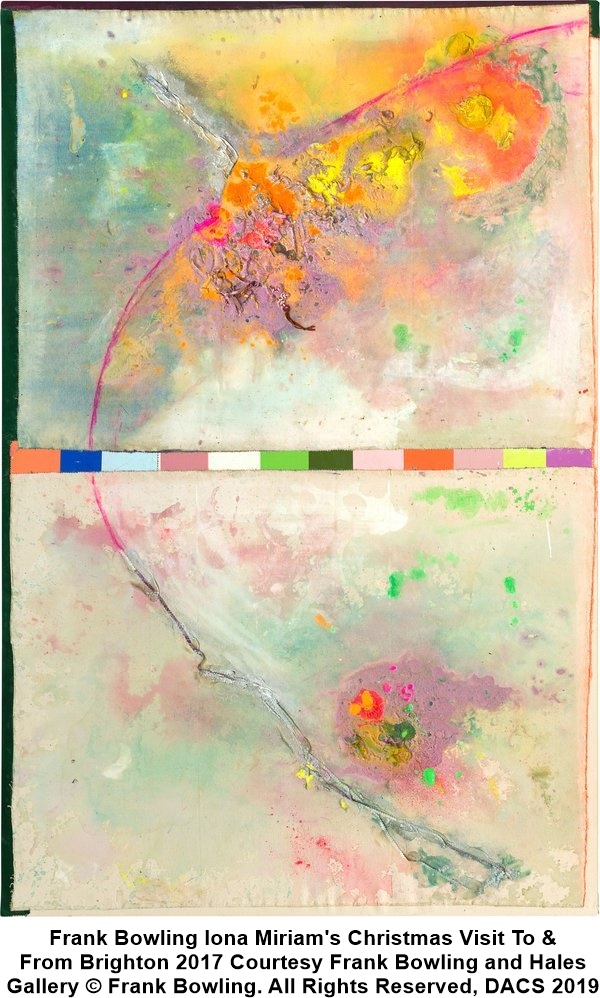 |
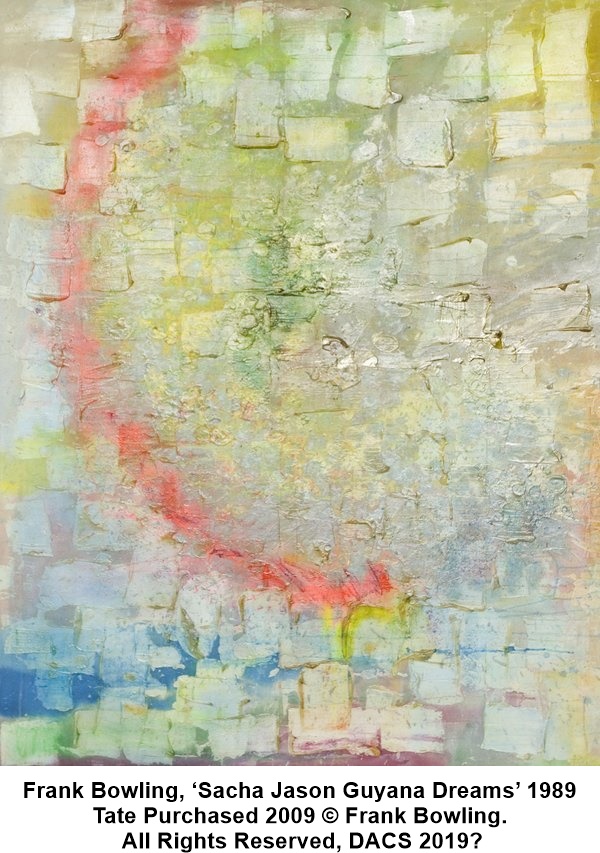 |
Alexander Gray Associates, along with Hales Gallery, London and Marc Selwyn Fine Art, Los Angeles, is pleased to announce the retrospective of Frank Bowling's work, curated by Elena Crippa, at Tate Britain, London.
For more than fifty years, Frank Bowling OBE, RA has challenged conventional understandings of painting, constructing lyrical compositions that integrate autobiography and postcolonial geopolitics into abstraction. The first black artist elected to the Royal Academy of Arts, the retrospective at Tate Britain celebrates Bowling's storied career and contributions to his chosen field, and includes highlights from series like the Map Paintings, Poured Paintings, and 1980s relief paintings, as well as more recent works.
Born in British Guiana in 1934, Bowling moved to London in 1953. Studying painting at the Royal College of Art from 1959–62 alongside David Hockney and R. B. Kitaj, he graduated at the height of the British Pop movement. Relocating to New York in 1966 to immerse himself in post-war American art, Bowling's practice shifted towards abstraction. After experimenting with silkscreening and stencils, he began to create his groundbreaking series of Map Paintings in the city in 1967. These expansive works juxtapose washes of expressive color with reoriented continental landmasses. As the curator Okwui Enwezor explains, "by staking a ground around the idea that abstraction need not be disunited from content, especially as it intersects cultural experience and historical subject matter, Bowling boldly experimented with diverse modes of building a painted surface." Constructing a personal and political cartography centered on issues of identity and post-colonialism, this series positioned Bowling alongside artists like Melvin Edwards, Sam Gilliam, Al Loving, Jack Whitten, and William T. Williams.
By the early 1970s, with the encouragement of Clement Greenberg, a close friend, Bowling had shed all figurative imagery to fully embrace post-painterly abstraction. With series like his Poured Paintings, he pushed the limits of the medium through his innovative "pour" technique that welcomed chance and spontaneity into the painting process. After moving back to London, in the 1980s Bowling built on this experimental approach, creating a series of canvases that challenged divisions between painting and sculpture through their three-dimensionality. Featuring strips of foam and heavy layers of gel medium, these works' craggy surfaces suggest geological strata. Expanding on his reliefs' allusions to the natural world, in later paintings from this decade, Bowling abstracted impressions of light and water to evoke J. M. W. Turner's landscapes, reflecting the influence of English Masters on his practice.
In more recent years, Bowling has introduced autobiographical elements into his paintings. Constructing collaged compositions from strips of canvas, he pays homage to his mother, a seamstress. At the same time, these works' gestural drips and spills of acrylic paint recall the Poured Paintings while their incorporation of disparate materials—glitter, plastic toys, and acrylic gel—into their surfaces refine the accretion of 1980s reliefs. Celebrating the unlimited potential of abstraction, these canvases reveal the artist's ongoing investigation into the nature and possibilities of painting.
A survey show of Bowling's paintings, Mappa Mundi, organized by Haus der Kunst, Munich, Germany, traveled to the Irish Museum of Modern Art (IMMA), Dublin, Ireland and the Sharjah Art Foundation, United Arab Emirates last year. His work is currently on view in Spilling Over: Color in the 1960s at the Whitney Museum of American Art, New York, NY, Mapping Black Identities at the Minneapolis Institute of Art, MN, and Soul of a Nation: Art in the Age of Black Power at The Broad, Los Angeles, CA. The exhibition was previously shown at the Tate Modern, London, United Kingdom, Crystal Bridges Museum of America, Bentonville, AK, and the Brooklyn Museum, NY and will travel to the de Young Museum, Fine Arts Museums of San Francisco, CA and The Museum of Fine Arts, Houston, TX in the coming year. Bowling's work is on view in many public collections, including the Metropolitan Museum of Art, New York, NY; Museum of Fine Arts (MFA), Boston, MA; The Museum of Modern Art, New York, NY; Royal Academy of Arts, London, United Kingdom; Tate Gallery, London, United Kingdom; Victoria and Albert Museum, London, United Kingdom; and Whitney Museum of American Art, New York, NY.
For more than fifty years, Frank Bowling OBE, RA has challenged conventional understandings of painting, constructing lyrical compositions that integrate autobiography and postcolonial geopolitics into abstraction. The first black artist elected to the Royal Academy of Arts, the retrospective at Tate Britain celebrates Bowling's storied career and contributions to his chosen field, and includes highlights from series like the Map Paintings, Poured Paintings, and 1980s relief paintings, as well as more recent works.
Born in British Guiana in 1934, Bowling moved to London in 1953. Studying painting at the Royal College of Art from 1959–62 alongside David Hockney and R. B. Kitaj, he graduated at the height of the British Pop movement. Relocating to New York in 1966 to immerse himself in post-war American art, Bowling's practice shifted towards abstraction. After experimenting with silkscreening and stencils, he began to create his groundbreaking series of Map Paintings in the city in 1967. These expansive works juxtapose washes of expressive color with reoriented continental landmasses. As the curator Okwui Enwezor explains, "by staking a ground around the idea that abstraction need not be disunited from content, especially as it intersects cultural experience and historical subject matter, Bowling boldly experimented with diverse modes of building a painted surface." Constructing a personal and political cartography centered on issues of identity and post-colonialism, this series positioned Bowling alongside artists like Melvin Edwards, Sam Gilliam, Al Loving, Jack Whitten, and William T. Williams.
By the early 1970s, with the encouragement of Clement Greenberg, a close friend, Bowling had shed all figurative imagery to fully embrace post-painterly abstraction. With series like his Poured Paintings, he pushed the limits of the medium through his innovative "pour" technique that welcomed chance and spontaneity into the painting process. After moving back to London, in the 1980s Bowling built on this experimental approach, creating a series of canvases that challenged divisions between painting and sculpture through their three-dimensionality. Featuring strips of foam and heavy layers of gel medium, these works' craggy surfaces suggest geological strata. Expanding on his reliefs' allusions to the natural world, in later paintings from this decade, Bowling abstracted impressions of light and water to evoke J. M. W. Turner's landscapes, reflecting the influence of English Masters on his practice.
In more recent years, Bowling has introduced autobiographical elements into his paintings. Constructing collaged compositions from strips of canvas, he pays homage to his mother, a seamstress. At the same time, these works' gestural drips and spills of acrylic paint recall the Poured Paintings while their incorporation of disparate materials—glitter, plastic toys, and acrylic gel—into their surfaces refine the accretion of 1980s reliefs. Celebrating the unlimited potential of abstraction, these canvases reveal the artist's ongoing investigation into the nature and possibilities of painting.
A survey show of Bowling's paintings, Mappa Mundi, organized by Haus der Kunst, Munich, Germany, traveled to the Irish Museum of Modern Art (IMMA), Dublin, Ireland and the Sharjah Art Foundation, United Arab Emirates last year. His work is currently on view in Spilling Over: Color in the 1960s at the Whitney Museum of American Art, New York, NY, Mapping Black Identities at the Minneapolis Institute of Art, MN, and Soul of a Nation: Art in the Age of Black Power at The Broad, Los Angeles, CA. The exhibition was previously shown at the Tate Modern, London, United Kingdom, Crystal Bridges Museum of America, Bentonville, AK, and the Brooklyn Museum, NY and will travel to the de Young Museum, Fine Arts Museums of San Francisco, CA and The Museum of Fine Arts, Houston, TX in the coming year. Bowling's work is on view in many public collections, including the Metropolitan Museum of Art, New York, NY; Museum of Fine Arts (MFA), Boston, MA; The Museum of Modern Art, New York, NY; Royal Academy of Arts, London, United Kingdom; Tate Gallery, London, United Kingdom; Victoria and Albert Museum, London, United Kingdom; and Whitney Museum of American Art, New York, NY.
 |
Frank Bowling |
mpefm UNITED KINGDOM art press release
Opemimg times :
Monday to Sunday 10.00–18.00
Tate Britain is open until 22.00 on the first Friday of each month for Late at Tate Britain
PRICING
£13 / FREE for Members
Concessions £12
Family child 12–18 years £5
Under 12s FREE (up to four per family adult)
16–25? Join Tate Collective for £5 tickets
School groups must be booked in advance
Tickets can be booked online or by phone on +44 (0) 20 7887 8888 (9.45–18.00 daily)
QR of this press release
in your smartphone, tablet
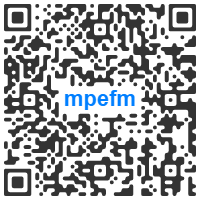
Tate Britain is open until 22.00 on the first Friday of each month for Late at Tate Britain
PRICING
£13 / FREE for Members
Concessions £12
Family child 12–18 years £5
Under 12s FREE (up to four per family adult)
16–25? Join Tate Collective for £5 tickets
School groups must be booked in advance
Tickets can be booked online or by phone on +44 (0) 20 7887 8888 (9.45–18.00 daily)
QR of this press release
in your smartphone, tablet








